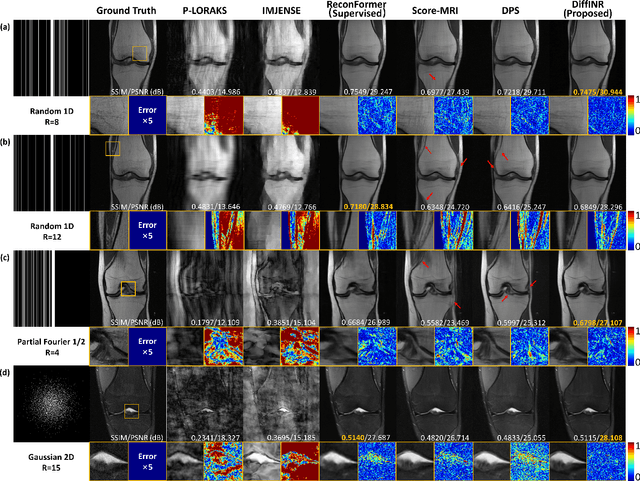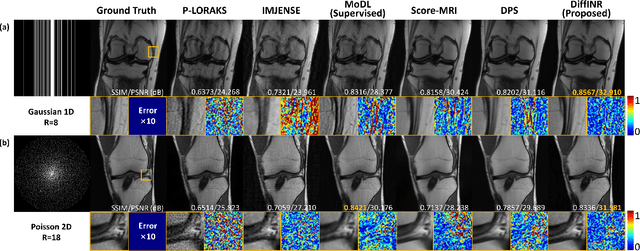Xiyue Lin
Highly Accelerated MRI via Implicit Neural Representation Guided Posterior Sampling of Diffusion Models
Jul 03, 2024


Abstract:Reconstructing high-fidelity magnetic resonance (MR) images from under-sampled k-space is a commonly used strategy to reduce scan time. The posterior sampling of diffusion models based on the real measurement data holds significant promise of improved reconstruction accuracy. However, traditional posterior sampling methods often lack effective data consistency guidance, leading to inaccurate and unstable reconstructions. Implicit neural representation (INR) has emerged as a powerful paradigm for solving inverse problems by modeling a signal's attributes as a continuous function of spatial coordinates. In this study, we present a novel posterior sampler for diffusion models using INR, named DiffINR. The INR-based component incorporates both the diffusion prior distribution and the MRI physical model to ensure high data fidelity. DiffINR demonstrates superior performance on experimental datasets with remarkable accuracy, even under high acceleration factors (up to R=12 in single-channel reconstruction). Notably, our proposed framework can be a generalizable framework to solve inverse problems in other medical imaging tasks.
Zero-Shot Image Denoising for High-Resolution Electron Microscopy
Jun 20, 2024Abstract:High-resolution electron microscopy (HREM) imaging technique is a powerful tool for directly visualizing a broad range of materials in real-space. However, it faces challenges in denoising due to ultra-low signal-to-noise ratio (SNR) and scarce data availability. In this work, we propose Noise2SR, a zero-shot self-supervised learning (ZS-SSL) denoising framework for HREM. Within our framework, we propose a super-resolution (SR) based self-supervised training strategy, incorporating the Random Sub-sampler module. The Random Sub-sampler is designed to generate approximate infinite noisy pairs from a single noisy image, serving as an effective data augmentation in zero-shot denoising. Noise2SR trains the network with paired noisy images of different resolutions, which is conducted via SR strategy. The SR-based training facilitates the network adopting more pixels for supervision, and the random sub-sampling helps compel the network to learn continuous signals enhancing the robustness. Meanwhile, we mitigate the uncertainty caused by random-sampling by adopting minimum mean squared error (MMSE) estimation for the denoised results. With the distinctive integration of training strategy and proposed designs, Noise2SR can achieve superior denoising performance using a single noisy HREM image. We evaluate the performance of Noise2SR in both simulated and real HREM denoising tasks. It outperforms state-of-the-art ZS-SSL methods and achieves comparable denoising performance with supervised methods. The success of Noise2SR suggests its potential for improving the SNR of images in material imaging domains.
DPER: Diffusion Prior Driven Neural Representation for Limited Angle and Sparse View CT Reconstruction
Apr 27, 2024



Abstract:Limited-angle and sparse-view computed tomography (LACT and SVCT) are crucial for expanding the scope of X-ray CT applications. However, they face challenges due to incomplete data acquisition, resulting in diverse artifacts in the reconstructed CT images. Emerging implicit neural representation (INR) techniques, such as NeRF, NeAT, and NeRP, have shown promise in under-determined CT imaging reconstruction tasks. However, the unsupervised nature of INR architecture imposes limited constraints on the solution space, particularly for the highly ill-posed reconstruction task posed by LACT and ultra-SVCT. In this study, we introduce the Diffusion Prior Driven Neural Representation (DPER), an advanced unsupervised framework designed to address the exceptionally ill-posed CT reconstruction inverse problems. DPER adopts the Half Quadratic Splitting (HQS) algorithm to decompose the inverse problem into data fidelity and distribution prior sub-problems. The two sub-problems are respectively addressed by INR reconstruction scheme and pre-trained score-based diffusion model. This combination initially preserves the implicit image local consistency prior from INR. Additionally, it effectively augments the feasibility of the solution space for the inverse problem through the generative diffusion model, resulting in increased stability and precision in the solutions. We conduct comprehensive experiments to evaluate the performance of DPER on LACT and ultra-SVCT reconstruction with two public datasets (AAPM and LIDC). The results show that our method outperforms the state-of-the-art reconstruction methods on in-domain datasets, while achieving significant performance improvements on out-of-domain datasets.
 Add to Chrome
Add to Chrome Add to Firefox
Add to Firefox Add to Edge
Add to Edge